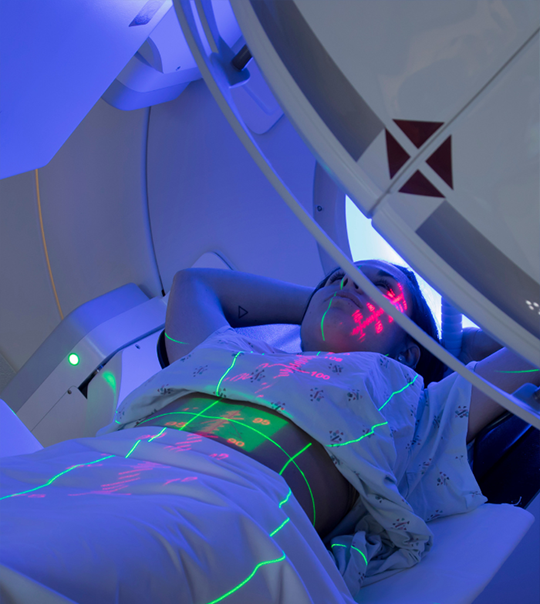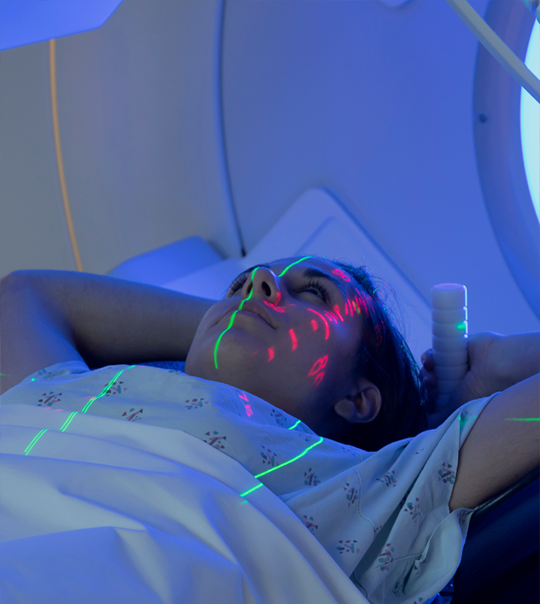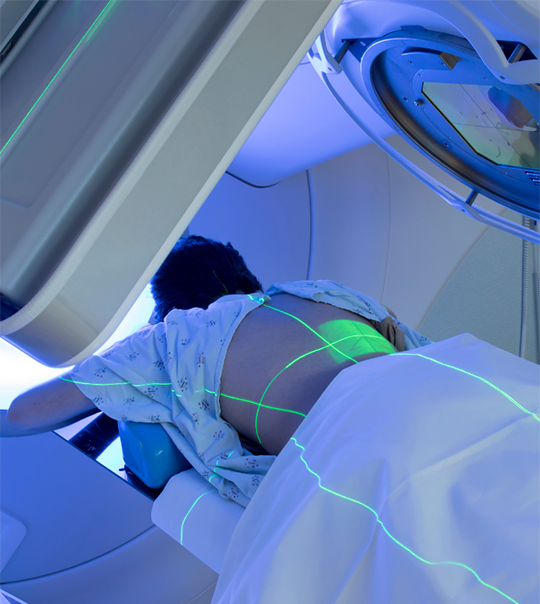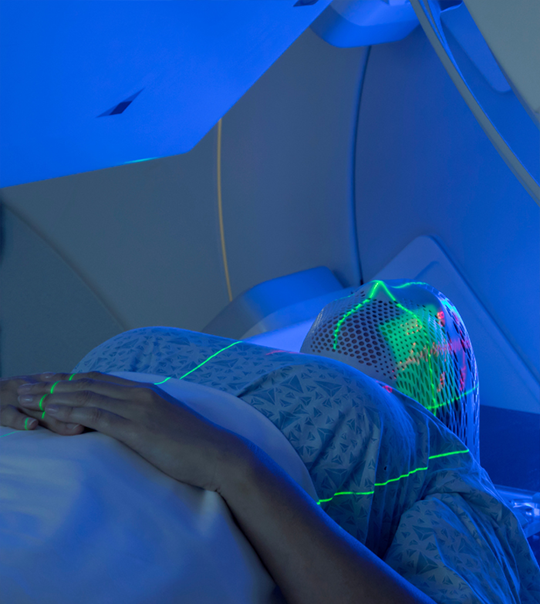
RADIATION TREATMENT
Low-Dose Radiation for Osteoarthritis
(LD-RT)
Low-dose radiation therapy (LD-RT) is a noninvasive treatment that involves using a smaller dose of radiation than standard radiation therapy to lower inflammation and treat painful musculoskeletal conditions. LD-RT can be used to manage pain in the hands, fingers, knees, hips, ankles, shoulders, and spine.
For some osteoarthritis patients, LD-RT may be used an alternative form of treatment for pain management after other methods have proven to be ineffective.
While a newer treatment in the United States, LD-RT is one of the most common treatments for osteoarthritis and musculoskeletal conditions in Europe, with studies showing a pain improvement rate of over 70% after the initial set of treatments. And patients that were interviewed two years after their initial LD-RT treatments continued to report lasting pain relief.
LD-RT is often used to treat plantar fasciitis, trochanteric bursitis, medial and lateral epicondylitis, tendinopathies of various joints, and osteoarthritis (OA) of both large and small joints.
How Low-Dose Radiation Therapy Changed One Patient’s Life
Many people think that radiation therapy is only used for malignant conditions and cancers, but the truth is that it can also be used to treat non-malignant conditions like osteoarthritis, Dupuytren’s contracture, and Ledderhose disease, plantar fasciitis, and tennis elbow. While not life threatening, these conditions can be very debilitating.
For some patients, radiation therapy can offer much-needed relief. That was the case for Shawn, a patient at Radiotherapy Centers of Kentuckiana. Shawn was suffering from osteoarthritis in his left knee, and the pain was ever-present and having a big impact on his daily life.
“Every day, going up and down stairs was torture. Playing with my grandkids was excruciating,” he says. “Picking them up was always painful. Work was torture on my knees. I always felt like they were going to explode.”
Even simple tasks like yard work could cause Shawn to be in pain for days afterward.
Patients with osteoarthritis may want to consider low-dose radiation therapy for osteoarthritis if they’re having worsening symptoms and a worsening quality of life despite other treatments such as NSAIDS, steroids, and joint injections. Radiation therapy for osteoarthritis is a low-risk option that can also be ideal for patients who are not good candidates for surgical options.
“I feel like this has given me a new lease on life, a freedom to do things that I would hesitate to do before,” Shawn says. After completing treatment, Shawn’s inflammation is gone, and his daily quality of life has increased significantly.
If you think low-dose radiation therapy for osteoarthritis may be a good option for you, please reach out to us today to schedule an initial consultation.
What to expect during LD-RT
A typical LD-RT regimen involves six to eight treatments either every other day or twice a week over the course of two to three weeks. Your individual treatment will vary depending on your general health and the radiation doses to surrounding tissues, and your doctor will take these into account when they decide how many treatments you will receive.
Each LD-RT session lasts 10 minutes, and multiple joints can be treated in the same session. Once the treatment begins, it’s normal to hear the equipment moving, clicking, and buzzing. If you notice an unfamiliar smell, that’s normal, too—it’s just the ozone produced by our linear accelerator. The radiation treatment shouldn’t hurt, burn, or sting. If you get uncomfortable because of the position you’re in, let us know.
Does Low-Dose Radiation Therapy Have Side Effects?
LD-RT is painless, with patients able to continue with their daily activities throughout treatment. Due to the low dosage of radiation, treatment for osteoarthritis has no reported acute side effects. A long-term review of over 1000 patients found that one patient reported some mild skin redness. No other acute or late effects were reported, and studies show the risk of secondary malignancy is negligible.
How Much Pain Relief Can Patients Expect? How Long Does Pain Relief Last?
Studies show a pain improvement rate of over 70 percent after the initial set of treatments, and most patients reported lasting pain relief two years after beginning LD-RT.
Is LD-RT suitable for older patients?
Yes! LD-RT is a recommended alternative treatment for older patients with refractory osteoarthritis who have not experienced effective pain relief with other treatments. Treatment can be given to the hands, fingers, knees, hips, ankles, shoulders, or spine.
Radiation Therapy Resources
Here are some resources to help you better understand your treatment; how to prepare for treatment; and what to expect before, during, and after treatment occurs.
What Foods Should I Eat if Radiation Causes Nausea?
The best foods to eat if radiation causes nausea include those that are bland, easy to digest, and nutritionally dense. Read more to learn which foods to avoid.
Choosing the Right Radiation Oncology Center for You
You get to choose where to receive radiation therapy. But how do you know what the right choice is for you? Here are some top things to consider.
Recovering From Head and Neck Cancer
The recovery time for head and neck cancer varies by patient. Here, we share some of the top factors that can impact your recovery time.
Types of Radiation Therapy
Image-guided radiation therapy (IGRT)
IGRT combines 3-D images with 3D or intensity-modulated radiation therapy to pinpoint and treat cancerous tumors.

Intensity-modulated radiotherapy (IMRT)
IMRT is an advanced form of external radiation treatment that allows precise targeting of tumor cells.

Image-guided radiation therapy (IGRT)
IGRT combines 3-D images with 3D or intensity-modulated radiation therapy to pinpoint and treat cancerous tumors.

Intensity-modulated radiotherapy (IMRT)
IMRT is an advanced form of external radiation treatment that allows precise targeting of tumor cells.

Stereotactic body radiotherapy (SBRT)
SBRT is an advanced type of radiation therapy that delivers high doses of radiation aimed at a very targeted area of the body.

3-D conformal radiation therapy
3-D CRT uses technology to capture 3D representations of the tumor and surrounding organs.

Stereotactic body radiotherapy (SBRT)
SBRT is an advanced type of radiation therapy that delivers high doses of radiation aimed at a very targeted area of the body.

3-D conformal radiation therapy
3-D CRT uses technology to capture 3D representations of the tumor and surrounding organs.

Schedule Your Appointment Today
If you are referred for radiation therapy during your cancer care, you get to choose where to receive treatment. We are here to support and encourage you—call us today to schedule your first appointment with one of our radiation oncologists at the cancer center nearest to you.



